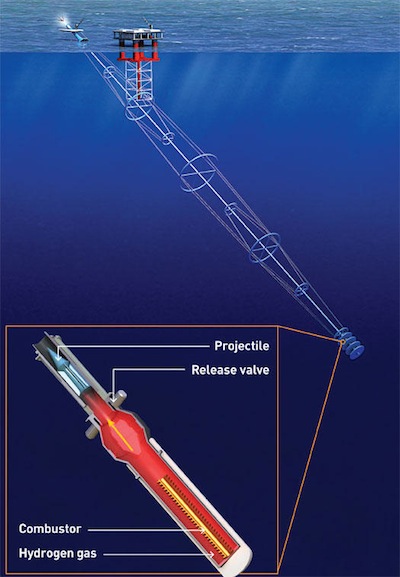Science Fiction
Dictionary
A B C D E F G H I J K L M N O P Q R S T U V W X Y Z
Quicklauncher Space Cannon

Quicklauncher is a space-cannon proposed by Lawrence Livermore National Laboratory physicist John Hunter. This 3,600-foot gun could make deliveries to an orbiting space station for just $250 per pound - compared to $5,000 per pound costs for delivery by rocket.

()
Hunter wants to operate the gun, the “Quicklauncher,” in the ocean near the equator, where the Earth’s fast rotation will help slingshot objects into space. A floating cannon—dipping 1,600 feet below sea level and steadied by a ballast system—would let operators swivel it for different orbits.Next month, Hunter will test a functional, 10-foot prototype in a water tank. He says a full-size launcher could be ready in seven years, provided the company can round up the $500 million. Despite the upfront cost, Hunter says he has drawn interest from investors because his reusable gun saves so much cash in the long haul.
Just don’t ever expect a ride in the thing: The gun produces 5,000 Gs, so it’s only for fuel tanks and ruggedized satellites. “A person shot out of it would probably get compressed to half their size,” Hunter says. “It’d be over real quick.”
In theory, it works like this: First, the gun combusts natural gas in a heat exchanger within a chamber of hydrogen gas. Operators open the valve, and the hot hydrogen expands down the tube, boosting the payload, which exits the mouth of the gun at 13.000 mph.
Here's a complete talk presented at Google in December, 2009 by John Hunter.
(John Hunter presents Quicklauncher space-cannon)
Jules Verne famously elaborates on the idea of a space-cannon in his excellent 1867 novel From the Earth to the Moon; here's the proposal for the Columbiad:
"You know," said he, "what progress artillery science has made during the last few years, and what a degree of perfection firearms of every kind have reached. Moreover, you are well aware that, in general terms, the resisting power of cannon and the expansive force of gunpowder are practically unlimited.Well! starting from this principle, I ask myself whether, supposing sufficient apparatus could be obtained constructed upon the conditions of ascertained resistance, it might not be possible to project a shot up to the moon?
...I have looked at the question in all its bearings, I have resolutely attacked it, and by incontrovertible calculations I find that a projectile endowed with an initial velocity of 12,000 yards per second, and aimed at the moon, must necessarily reach it. I have the honor, my brave colleagues, to propose a trial of this little experiment."
From Popular Science via Next Big Future.
Scroll down for more stories in the same category. (Story submitted 1/15/2010)
Follow this kind of news @Technovelgy.| Email | RSS | Blog It | Stumble | del.icio.us | Digg | Reddit |
Would
you like to contribute a story tip?
It's easy:
Get the URL of the story, and the related sf author, and add
it here.
Comment/Join discussion ( 5 )
Related News Stories - (" Space Tech ")
Will Space Stations Have Large Interior Spaces Again?
'They filed clumsily into the battleroom, like children in a swimming pool for the first time, clinging to the handholds along the side.' - Orson Scott Card, 1985.
Reflect Orbital Offers 'Sunlight on Demand' And Light Pollution
'I don't have to tell you about the seven two-mile-diameter orbital mirrors...'
Chrysalis Generation Ship to Alpha Centauri
'This was their world, their planet —
this swift-traveling, yet seemingly moveless vessel.' - Nat Schachner, 1934
The First Space Warship For Space Force
'Each of the electrical ships carried about twenty men...' - Garrett P. Serviss, 1898.
Technovelgy (that's tech-novel-gee!) is devoted to the creative science inventions and ideas of sf authors. Look for the Invention Category that interests you, the Glossary, the Invention Timeline, or see what's New.
Science Fiction
Timeline
1600-1899
1900-1939
1940's 1950's
1960's 1970's
1980's 1990's
2000's 2010's
Current News
Golf Ball Test Robot Wears Them Out
"The robot solemnly hit a ball against the wall, picked it up and teed it, hit it again, over and again...'
Boring Company Vegas Loop Like Asimov Said
'There was a wall ahead... It was riddled with holes that were the mouths of tunnels.'
Rigid Metallic Clothing From Science Fiction To You
'...support the interior human structure against Jupiter’s pull.'
Is The Seattle Ultrasonics C-200 A Heinlein Vibroblade?
'It ain't a vibroblade. It's steel. Messy.'
Roborock Saros Z70 Is A Robot Vacuum With An Arm
'Anything larger than a BB shot it picked up and placed in a tray...'
A Beautiful Visualization Of Compact Food
'The German chemists have discovered how to supply the needed elements in compact, undiluted form...'
Bone-Building Drug Evenity Approved
'Compounds devised by the biochemists for the rapid building of bone...'
Secret Kill Switch Found In Yutong Buses
'The car faltered as the external command came to brake...'
Inmotion Electric Unicycle In Combat
'It is about the size and shape of a kitchen stool, gyro-stabilized...'
Grok Scores Best In Psychological Tests
'Try to find out how he ticks...'
PaXini Supersensitive Robot Fingers
'My fingers are not that sensitive...'
Congress Considers Automatic Emergency Braking, One Hundred Years Too Late
'The greatest problem of all was the elimination of the human element of braking together with its inevitable time lag.'
The Desert Ship Sailed In Imagination
'Across the ancient sea floor a dozen tall, blue-sailed Martian sand ships floated, like blue smoke.'
The Zapata Air Scooter Would Be Great In A Science Fiction Story
'Betty's slapdash style.'
Thermostabilized Wet Meat Product (NASA Prototype)
There are no orbiting Michelin stars. Yet.
Could Crystal Batteries Generate Power For Centuries?
'Power could be compressed thus into an inch-square cube of what looked like blue-white ice'
